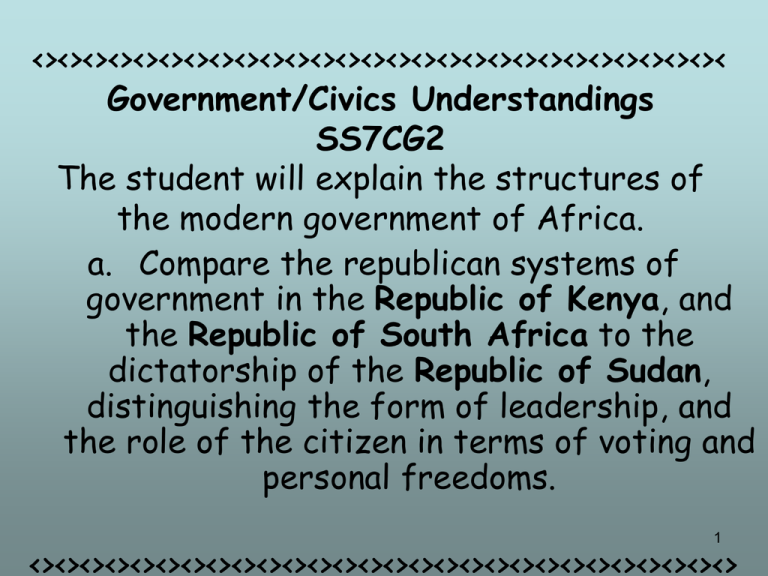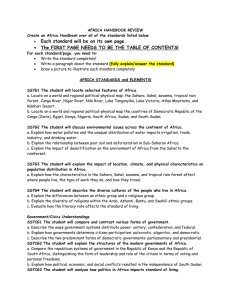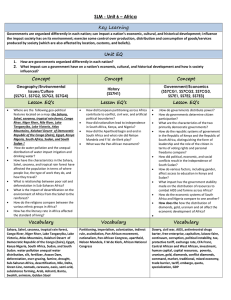SS7CG2a SS7CG3ab Govt-Civics Understandings
advertisement

<><><><><><><><><><><><><><><><><><><><><><><><><><><>< Government/Civics Understandings SS7CG2 The student will explain the structures of the modern government of Africa. a. Compare the republican systems of government in the Republic of Kenya, and the Republic of South Africa to the dictatorship of the Republic of Sudan, distinguishing the form of leadership, and the role of the citizen in terms of voting and personal freedoms. 1 The countries of Kenya, Africa, and Sudan have very different governmental systems today. All three are described as “republics,” or a country in which supreme governing power is held by the citizens having the right to vote and is exercised by representatives elected by and responsible to the voters. The reality, however, is very different in each country. ****************************************** The following chart describes each country’s government, head of state, who can vote, the degree of personal freedoms for its citizens, and the year of independence from colonial rule. 2 Country Type of Govt. Head of State Who Can Vote Degree of Personal Freedom for Citizens Year of Independence from Colonial Rule Republic of Kenya Republic, with one-house legislature called National Assembly President leads the Kenyan African National Union (KANU) political party All citizens 18 years of age and older can vote Freedoms are written onto the constitution, but gov’t is dominated by the president. There’ve been improvements in citizens’ rights in recent years. Kenya became independent from Great Britain in 1963. Republic of South Africa Republic, with a two-house National Assembly President elected by the National Assembly All citizens 18 years of age and older can vote. Personal freedoms are numerous. Apartheid (legal separation of the races) has ended. Literacy rates are high. South Africa became independent from Great Britain in 1910. The racially segregated govt. was ended in 1994, when majority rule was established. Republic of Sudan A govt. of national unity was formed with a National Legislature. The govt. is dominated by the National Congress Party, however. President and Head of State lead the National Congress Party All citizens 17 years of age and older can vote. Citizens of Sudan have few real freedoms unless they are associated with the Natl. Congress Party. Most govt. positions are appointed. Elections are supposed to be held in the future. Sudan became independent of Egypt and Great Britain in 1956. 3 ~~~~~~~~~~~~~~~~~~~~~~~~~~~ SS7CG3 The student will analyze how politics in Africa impacts the standard of living. a. Compare how various factors, including gender, affect access to education in Kenya and Sudan. ~~~~~~~~~~~~~~~~~~~~~~~~~~~~ 4 The Republic of Kenya and the Republic of Sudan present very different pictures when looking at how the two countries provide education for their children. Factors like money, political stability, and even traditions play a part in shaping the educational systems of the two countries. 5 Kenya The country of Kenya currently has a national literacy rate of about 85%, a figure that ideally could be made higher, but one that has improved a lot in recent decades. The Kenyan government has made improving education a priority. Below: a photo of Kenyan school children 6 The Kenyan government has started a number of government programs for building schools and eliminating fees for the children who want to go to school. Kenya has a Ministry of Education whose motto is “Quality Education for Development.” Above: School children in Mombasa, Kenya’s city at the coast. 7 About 85% of Kenya’s school-age children attend elementary school. That percentage drops to 24% for high school, and only 2% for college. The Ministry of Education is trying to keep more children in school by offering vocational and technical education by the year 2010. Above: the school children of Thugunui 8 Kenya currently spends about 7% of their national budget on education. They’ve also gotten some help from organizations like the United Nations and the World Bank to offer more educational opportunities to the Kenyan children. Above: Thugunui school children 9 Kenya also has a number of universities, both public and private, though only a small percentage of students in Kenya go on to study at that level. Above: Kabarak University 10 Unfortunately, the Kenyan literacy rate of 85% doesn’t show the gap that exists between boys and girls in Kenya. The literacy rate of boys is about 91%, while the rate for girls is 79%. The wide gap can be explained by several factors. Literacy and school attendance rates are higher in urban areas than in rural areas, but are still much lower for girls. Above: Female students in Kenya 11 Teachers in Kenya still have to work to get many rural families to see the importance of education for girls. The traditional view is that boys need education to get better jobs, but girls only need to prepare for marriage. Early marriages are very common in rural parts of Kenya, and a marriage brings a dowry to the bride’s family. A dowry is money or gifts the groom and his family gives to the bride and her parents as a wedding present. 12 Above: A traditional Kenyan Wedding Sudan The Republic of Sudan has not quite made the progress in education that is seen in Kenya. They have been involved in a civil war for many years, and that conflict has meant chaos, or complete confusion and disorder for the southern and western parts of the country. 13 Sudan has a national literacy rate of about 61%, but with a wide gap between boys and girls. Sudan’s boys have a literacy rate of about 72 % while girls have a rate of only 50%. Above: Children in front of Good Hope School, Bentiu, Sudan 14 The military conflict in Sudan’s countryside has left many schools in ruins. Those children who live in cities have the best chance of getting an education. Boys’ educational programs receive about 2/3 of the available money, while girls programs only get about 1/3. Educational reform was introduced in the 1990s, but emphasis was placed mainly on expanding students’ religious education. 15 Above: People in a village near Geneina, West Darfur, a region in Sudan, survey the damage to a newly constructed school building. Sudanese girls face many of the same problems as girls throughout Africa who live in rural or traditional communities. Many parents are concerned that allowing girls to go to public schools will result in their learning bad behavior. Above: photo of a Sudanese girl 16 Parents also feel that if there is money to be spent on education, it should go to their sons who will have to learn a living. Daughters are often see as needing only to prepare for marriage. A married daughter means wealth for both families with dowry money for the bride’s family and a new household worker for the groom’s family. Above: traditional Sudanese wedding 17 Many girls who are allowed to go to school are sent to religious school where they mainly study the Quran. Above: photo of the Wadi Halfa mosque in Sudan 18 ************************************ SS7CG3 The student will analyze how politics in Africa impacts the standard of living. b. Describe the impact of government stability on the distribution of resources to combat AIDS and famine across Africa. ************************************ 19 Sub-Saharan Africa has one of the highest rates of HIV-AIDS infections in the world. It’s estimated that there are about 23 million people in the world living with AIDS and another 1.5 million that have died from the disease. Because so many of the victims are young and middle-aged adults, their deaths have left Africa with over 11 million orphans. Above: The faces of HIV/AIDS in Africa 20 Some orphans, or children with no parents, have been able to move in with relatives, but many thousands of others have no one to take care of them and must try to survive on their own. Virtually all of the children in the above photos have lost both parents, most of them to AIDS. Malaria, yellow fever and especially TB are fatal illnesses here, too. The children's grandparents have also died or are too poor and sick to care for the children; the same is true of their 21 aunts and uncles, their neighbors and teachers. The extent of this disease in Africa is just being understood. Most health officials expect the numbers of those infected and of those who will die will increase in the next ten years. Poor health care systems, poverty, and lack of government organization, as well as ignorance about the disease and its prevention all contribute to the rapidly expanding number of cases. 22 Above right: AIDS activist Zackie Achmat speaking at the 2009 South African AIDS Conference in Durban; Left: and HIV positive couple in South Africa There are antiretroviral drugs (AVTs) that are able to slow down the progress of the disease, but they’re expensive and beyond the budget of many of the people who are infected. Above left: Electron micrograph image of cell producing HIV; Right: the antiretroviral drug stavudine, marketed as Zerit 23 The country of South Africa is a different story. Health officials at the United Nations have estimated that one in every five South Africans may be infected with HIV/AIDS. However, few people can get the drugs they need to slow the disease. The red ribbon is an international symbol of AIDS awareness. It symbolizes care and concern about HIV and AIDS, and reminds people of the need for commitment to tackling the epidemic. 24 Above: South African red ribbon badge AIDS took hold of South Africa in the 1990s when the country was trying to end the old apartheid system of legal racial segregation. The early days of the HIV epidemic were overshadowed by the nation’s other problems. Above left: Apartheid era sign written in English and Afrikaans; Left: Men leaving the city to go back to their township at night;25 Sign warns, “Caution: Beware of the natives” Some see HIV/AIDS as a disease only of the poor. Some men blame it on the women. Ignorance has a real impact of how rapidly this disease spreads. Above left: A road sign in Zambia confronting the "virgin AIDS cure myth" which wrongly claims that sex with a virgin can cure AIDS. This belief by some men has led to the widespread sexual abuse of young African girls. Right: An HIV prevention sign in Zambia promoting 26 abstinence, fidelity and condom use The country of Zimbabwe has one of the highest rates of HIV/AIDS infection in the world. Government corruption, civil unrest, and suspicion of offers of help from other countries have made Zimbabwe’s problems even greater. Above: People sitting by an HIV/AIDS awareness sign in Zimbabwe27 Zimbabwe’s poor economy has made expensive AVTs impossible to afford. Political turmoil and a harsh government have created many refugees in Zimbabwe, making the health crisis even worse. Above left: Refugees from Zimbabwe sheltering in Central United Methodist Church in Johannesburg, South Africa; Right: People evicted from their homes shelter in overcrowded conditions in a church yard in Bulawayo, Zimbabwe. The government has since evicted these refugees from the church and transported them to the rural areas. 28 Nigeria has a 3.1 % HIV/AIDS infection rate which is relatively low in comparison to some other African countries. However, Nigeria has a very large population, so that 3.1 % translates into almost 3 million people who are currently infected. Above: Ads and posters found at NigeriaHIVinfo.com, Nigeria’s29 HIV/AIDS official information website. Though Nigeria has oil, most Nigerians are relatively poor, and the Nigerian government didn’t make HIV/AIDS a priority or a top issue of great importance until the late 1990s. Since then, Nigeria has made HIV/AIDS prevention, treatment, and care a main concern. Above photo: The anxiety in Christian's deeply recessed eyes speaks more eloquently of his condition than the gurgle of words that he struggles to get out between coughs and wheezes from his fluid-filled lungs. A 27-year-old electronic equipment technician, Christian has only recently found out that he has the virus. It has30 left him defenseless against the infection that is ravaging his chest While Nigeria still has to struggle with the HIV/AIDS problem, the government is working hard to educate their citizens and make treatment available. Above photo: When the hospital discovered that Abigail's’ daughter Rachel was HIV positive, they informed the church; both church and husband abandoned her. Abigail was ostracized by her bible study group and her hairdresser while the nursery expelled Rachel. Abigail's worst fears came true. Her daughter developed an intestinal infection and with her 31 immune system compromised, died. Botswana, a country with a high rate of infection, has also been one of the countries to mount the most effective response to the disease. Botswana has had four decades of peace since gaining their independence in 1966. Above photo: Victoria Falls at sunset. 32 The country has a sound economy because of the diamond trade. Even though many Botswanans are still poor, the country’s government has provided education and prevention training for its citizens and medical care for those who are already infected. Above left: The discovery of diamonds was the most important catalyst in Botswana’s economic growth; Right: De Beers Diamond Jewellers Ltd. 33 entered into a 50-50 joint venture with the government of Botswana. Famine Many African countries today face famine, or a serious shortage of food, because of climate changes, political conflict which disrupts farming, poor prices for African goods on the world market, disease, and poorly organized or corrupt governments. 34 Above: Photos show one of the smallest victims of famine, Fatuma Hillow who weighs less than ten pounds. The country of Zimbabwe is an example of how poorly thought out government policies can lead to famine and starvation. A land reform program that was begun was to have placed more land in the hands of native Zimbabweans. Above map shows some areas in Africa that have been hit hard 35 by drought and famine. Old landowners, many of whom had been associated with the apartheid systems of the colonial days, were run off the land. In the chaos that followed, many farmers failed to produce under their new owners, and food shortages quickly followed. Above left: Fatuma Hillow, 2, being weighed on a scale to check her progress; 36 Right: Ubah Adow gives her son Ijabo Adow, 2, his daily medicine to battle malnutrition. He has been at the hospital for two months. Angola The country of Angola just ended a long civil war. People thought this would bring back some prosperity or success to the country. However, hundreds of thousands of Angolans who had left the country during the civil war returned and food shortages quickly followed. During the war, Angola's capital city of Luanda has swollen to more than three million people, many of them displaced rural families now living in 37 neighborhoods with no public services. Republic of Sudan The Republic of Sudan has also experienced famine during their 20 years of civil war. Millions of Sudanese in the southern part of the country are now dependent on international aid to avoid starvation. Above photos: Civil war in Sudan pitted Muslim north against Christian, animist south. Right: These child soldiers have now become students. 38 Uganda The country of Uganda has had to deal with fighting among a wide variety of armed people, including different ethnic groups, rebel forces trying to overthrow the government, armed gangs, and military factions. Below is the flag of Uganda with the national bird, the crane, in the center. 39 Though Uganda is more stable than in earlier years after independence, conflict continues to disrupt agriculture and trade, making food shortages common. 40 Above left: tea plantation in Uganda; Right: country dwelling in Uganda





